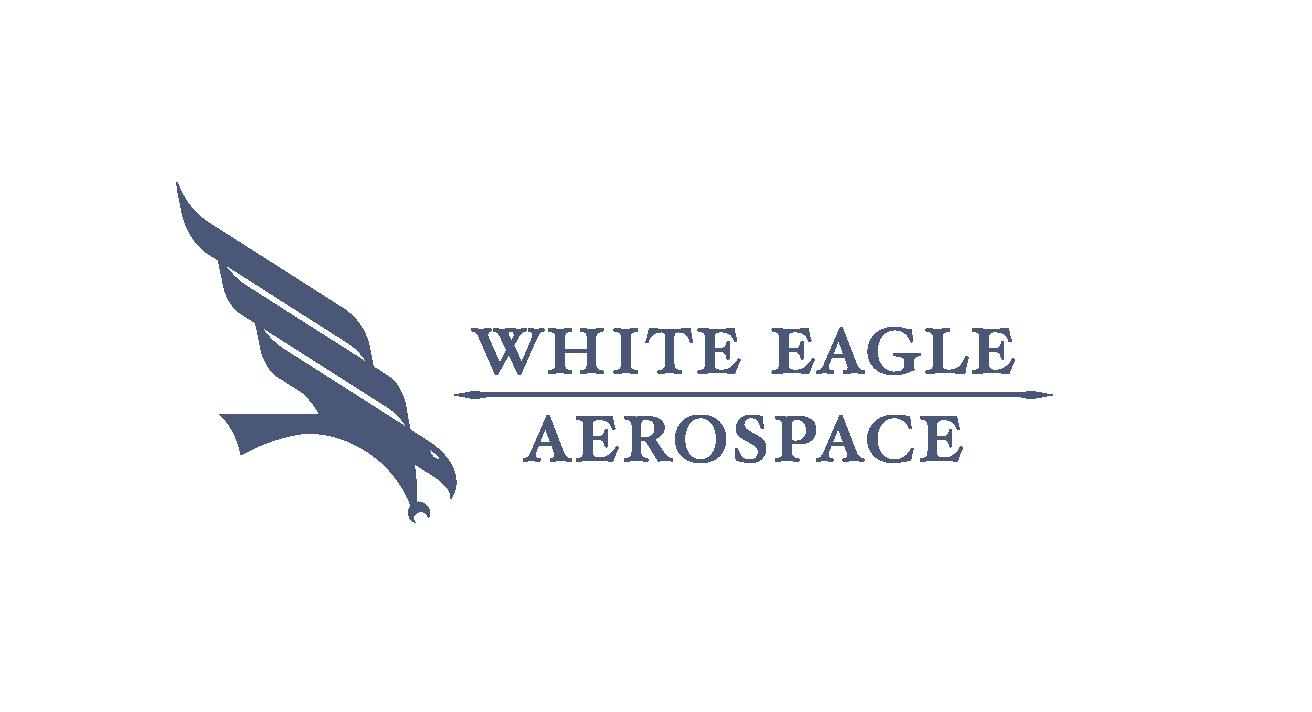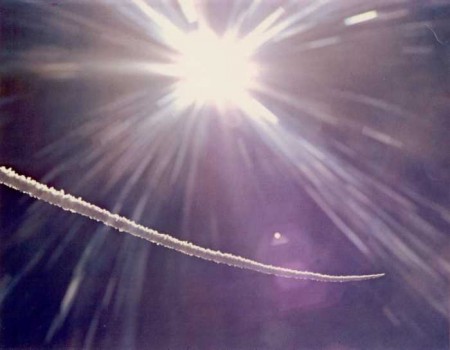
Fifty years ago this month, NASA chief research pilot Joseph A. Walker flew X-15 Ship No. 3 (S/N 56-6672) to an altitude of 354,200 feet. This flight would mark the highest altitude ever achieved by the famed hypersonic research vehicle. The date was Thursday, 22 August 1963.
Carried aloft by NASA’s NB-52A (S/N 52-0003) mothership, Walker’s X-15 was launched over Smith Ranch Dry Lake, Nevada at 17:05:42 UTC. Following drop at around 45,000 feet and Mach 0.82, Walker ignited the X-15′s small, but mighty XLR-99 rocket engine and pulled into a steep vertical climb.
The XLR-99 was run at 100 percent power for 85.8 seconds with burnout occurring around 176,000 feet on the way uphill. Maximum velocity achieved was 3,794 miles per hour which tranlates to Mach 5.58 at the burnout altitude. Following burnout, Walker’s X-15 gained an additional 178,200 feet in altitude as it coasted to apogee.
Joe Walker went over the top at 354,200 feet (67 miles). Although he didn’t have much time for sight-seeing, the Earth’s curvature was strikingly obvious to the pilot as he started downhill from his lofty perch. Walker subsequently endured a hefty 5-g’s of eyeballs-in normal acceleration during the backside dive pull-out. The aircraft was brought to a wings-level attitude at 70,000 feet. Shortly after, Walker greased the landing on Rogers Dry Lake at Edwards Air Force Base, California.
The X-15 maximum altitude flight lasted 11 minutes and 8 seconds from drop to nose wheel stop. In that time, Walker and X-15 Ship 3 covered 305 miles in ground range. The mission was Ship No. 3′s 22nd flight and the 91st of the X-15 Program.
For Joseph Albert Walker, the 22nd of August 1963 marked his 25th and last flight in an X-15 cockpit. The mission qualified him for Astronaut Wings since he had exceeded the 328,000 foot (100 km) FAI/NASA standard set for such a distinction. Strangely, the historic record indicates that Joe Walker never officially received Astronaut Wings for this flight in which the X-15 design altitude was exceeded by more than 100,000 feet.
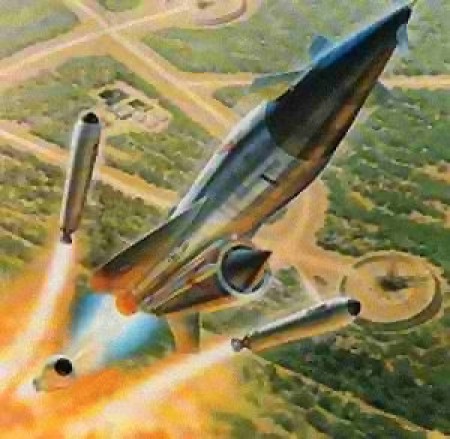
Forty-nine years ago this month, the United States abandoned a 7-year effort to develop a nuclear-armed, supersonic cruise missile. The joint USAF-AEC program was known as Project Pluto. The centerpiece of this program was the nuclear-fueled, ramjet-powered Supersonic Low-Altitude Missile (SLAM).
The 1950′s saw the development of myriad aircraft, missile and submarine concepts designed for delivery of nuclear weaponry over strategic distances. This developmental activity was driven by the escalating Cold War between the United States and the Soviet Union. In addition to weapons, the power of the atom was also considered for propulsion applications during this era.
SLAM was perhaps the most fearsome weapon ever conceived. The missile was designed to deliver as many as 26 nuclear bombs over the Soviet Union in a single mission. It would do this while flying at Mach 3 and less than 1,000 feet above ground level. SLAM’s shock wave overpressure alone (162 dB) would devastate structures and people along its flight path. And, as if that were not enough, the type’s nuclear-fueled ramjet would continuously spew radiation-contaminated exhaust all over the countryside.
The SLAM airframe was huge. It measured 88 feet in length, nearly 6 feet in diameter and weighed 61,000 pounds at launch. The vehicle would be fired from a ground-based launch site and accelerated to ramjet takeover speed by a trio of jettisionable rocket boosters. The nuclear-fueled ramjet was rated at 35,000 pounds of thrust.
To find its way to the target area(s), the Ling-Temco-Vought (LTV) SLAM would use a guidance system known today as TERCOM – Terrain Contour Matching. At a target, SLAM would eject an atomic warhead upwards from its payload bay. The resulting lofted trajectory gave SLAM time to depart the hot target area prior to weapon detonation. Following completion of its mission, the missile would then ditch itself by diving into a deep ocean graveyard.
The heart of the Project Pluto missile was the nuclear-fueled ramjet. An unshielded nuclear reactor, code named TORY, was devised, built and successfully tested. Testing was conducted at a special-purpose test site in Nevada. In its Tory II-C configuration, the SLAM ramjet produced over 500 megawatts of power in 5 minutes of continuous operation during a test conducted in May of 1964.
SLAM’s nap-of-the-earth, supersonic flight profile would subject the airframe to terrific airloads, vibrations and temperatures. The Project Pluto team successfully devised structural and thermal material solutions to handle the daunting flight environment. In addition, nuclear-hardened electronics and flight controls were successfully developed.
From a technological standpoint, Project Pluto proved to be entirely viable. However, doubts about its implementation started to arise as flight testing of the nuclear-powered missile was seriously considered. Where do you flight-test a radiation-spewing missile? What happens if you can’t turn-off the reactor? What do you do if the guidance system fails? Where do you dispose of the missile after a flight test? These and other disturbing questions began to trouble program officials.
Coupled with the above practical concerns of SLAM flight testing were growing political and mission obsolesence issues. Pentagon officials ultimately deemed Project Pluto as being highly provocative to the Soviet Union in the sense that the communist super power might feel compelled to develop their own SLAM. Further, American missilery was quickly developing to the point where ICBM-delivered warheads would do the job and at a lower per-unit cost.
So it was that on Wedneday, 01 July 1964, Project Pluto was canceled after 7 years of fruitful development. While no airframe was ever built and tested, SLAM technology was applied to a host of subsequent aerospace vehicle developments.
SLAM would truly have been “The Missile From Hades” had it matured to the point of flight. Indeed, the ethical issues concerning the missile’s use were quite sobering. And, owing to Murphy’s Law and its many corollaries, the chances for unintended catastrophe were high as well. Despite the allure of this ”technically sweet” solution to a national defense problem, the decision to cancel Project Pluto was ultimately the only correct course to follow.

Forty-four years ago this month, the United States of America landed two men on the surface of the Moon.
The Apollo 11 Lunar Module Eagle landed in Sea of Tranquility region of the Moon on Sunday, 20 July 1969 at 20:17:40 UTC. Less than seven hours later, astronauts Neil A. Armstrong and Edwin E. Aldrin, Jr. became the first human beings to walk upon Earth’s closest neighbor. Fellow crew member Michael Collins orbited high overhead in the Command Module Columbia.
As Apollo 11 commander, Neil A. Armstrong was accorded the privilege of being the first man to step foot upon the Moon. As he did so, Armstrong spoke these words: “That’s one small step for Man; one giant leap for Mankind”. He had intended to say: “That’s one small step for ’a’ man; one giant leap for Mankind”.
Armstrong and Aldrin explored their Sea of Tranquility landing site for about two and a half hours. Total lunar surface stay time was 22 hours and 37 minutes. The Apollo 11 crew left a plaque affixed to one of the legs of the Lunar Module’s descent stage which read: “Here Men From the Planet Earth First Set Foot Upon the Moon; July 1969, A.D. We Came in Peace for All Mankind”.
Following a successful lunar lift-off, Armstrong and Aldrin rejoined Collins in lunar orbit. Approximately seven hours later, the Apollo 11 crew rocketed out of lunar orbit to begin the quarter million mile journey back to Earth. Columbia splashed-down in the Pacific Ocean at 16:50:35 UTC on Thursday, 24 July 1969. Total mission time was 195 hours, 18 minutes, and 35 seconds.
With completion of the flight of Apollo 11, the United States of America fulfilled President John F. Kennedy’s 25 May 1961 call to land a man on the Moon and return him safely to the Earth before the decade of the 1960′s was out. It had taken 2,982 demanding days and much national treasure to do so.
Mission Accomplished, Mr. President.
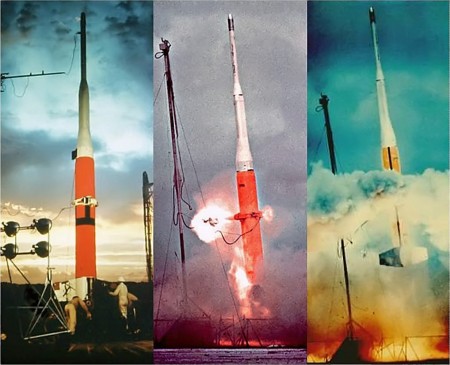
Fifty-seven years ago this week, the triple-staged USAF/Lockheed X-17 successfully flew its first aerodynamic heating research mission. The hemispheric reentry test article achieved a peak Mach number of 12.84 during the high temperature flight experiment.
In the early 1950’s, the United States began developing its first stable of Intercontinental Ballistic Missiles (ICBM’s). Among the many technical issues facing engineers at that time, perhaps the most vexing was that of reentry vehicle survivability owing to the extreme temperatures encountered in hypersonic flight. These high temperatures resulted from the flow deceleration which occurred within the reentry vehicle bow shock wave as kinetic energy was transformed to thermal energy.
The temperatures within the shock layer of a hypersonic reentry vehicle can exceed 10,000 degrees Fahrenheit. Indeed, there is enough kinetic energy in the flow that should it all be converted to thermal energy, the reentry vehicle material would be vaporized. The pressing challenge in the 1950’s was to determine how to shape the vehicle such that the kinetic-to-thermal energy conversion process transferred most of the energy to the air rather than the vehicle.
H. Julian Allen and Alfred Eggers of the National Advisory Committee for Aeronautics (NACA) discovered that a blunted forebody would significantly reduce the magnitude of aerodynamic heating relative to that of a sharp or pointed body. However, the concept needed to be tested to confirm its validity. Wind tunnels that could provide full-scale flight Mach number, Reynolds number, and temperature similitude did not exist at the time. Thus, the only recourse was flight test.
The X-17 Program was established to provide the first hypersonic, high-altitude flight data relative to entry vehicle aerodynamic heating. The United States Air Force contracted with Lockheed for development of a vehicle capable of boosting reentry vehicle test articles to hypersonic flight conditions. The idea was to acquire aerodynamic heating data for various reentry vehicle shapes. The fast-paced program was driven by the urgency of national defense interests.
The Lockheed-developed X-17 was a three-stage vehicle. It measured 40.5 feet in length and had a maximum diameter of 31 inches. The first stage rocket motor did the heavy lifting. The Thiokol XM-20 solid rocket motor produced an average thrust of 48,000 lbs for 28 seconds. Burnout occurred at Mach 5 and 90,000 feet.
Following first stage burnout, the entire X-17 launch stack coasted to an apogee of about 500,000 feet. The vehicle went over the top at around Mach 0.8. The gravitationally-aided fall back toward the earth caused the vehicle’s velocity to build-up rapidly. Indeed, as the X-17 passed through 120,000 feet on the way downstairs, the Mach meter reading was back up to 5.
Second stage propulsion consisted of a trio of Thiokol XM-19 rocket motors which produced a combined thrust of 101,700 lbs for 1.5 seconds. These motors were ignited shortly after the empty first stage was jettisoned. The resulting high acceleration drove the vehicle to a Mach number approaching 10 as the X-17 passed through 72,000 feet. The second stage was jettisoned just after burnout.
A single XM-19 rocket motor comprised third stage propulsion. Peak acceleration was better than 90 g’s resulting in the X-17 payload reaching a burnout Mach number of about 14 at 55,000 feet. The temperature measurement period between maximum Mach number and Mach 2 was brief; on the order of 10 seconds. These temperature data were telemetered to the ground since the test article was completely destroyed at impact.
The first X-17 aerodynamic heating research mission was launched on Wednesday, 17 July 1956 from the Air Force Missile Test Center (AFMTC) near Cape, Canaveral Florida. The X-17 system worked well as the hemispheric reentry vehicle test article reached a maximum velocity of 8,184 mph or Mach 12.84. Apogee for this first X-17 research mission occurred at an altitude of 465,000 feet.
A total of twenty-five (25) aerodynamic heating research missions would ultimately be flown during the X-17 Program. The last of which occurred in March of 1957. This very successful test effort produced a wealth of first-ever heat transfer data that helped write the book on reentry vehicle design. Key findings included the effects of boundary layer transition, external shape, and high temperature material thermal response.
The X-17 Program was among the most important of the 1950’s. Indeed, both the Atlas and Titan Programs conducted initial tests of their respective reentry vehicle designs using the X-17 as a testbed. The upshot of this is that the United States was able to develop survivable reentry vehicles in a timely fashion during the height of the Cold War.
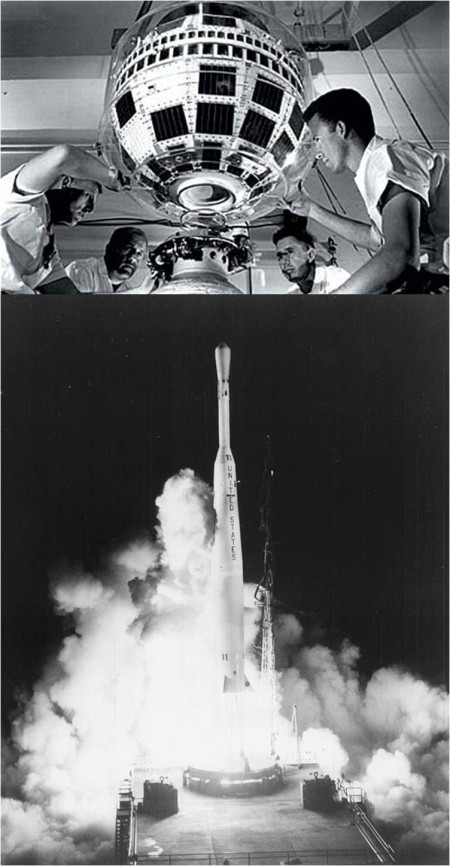
Fifty-one years ago this week, the United States successfully orbited the world’s first active-repeater communications satellite. Known as Telstar 1, the satellite successfully relayed through space the first television pictures, telephone calls, fax images and provided the first live transatlantic television transmission.
Telstar was a development of the Bell Telephone Laboratories for the American Telephone and Telegraph (AT&T) Company. The concept involved orbiting of a satellite that could receive, amplify and retransmit electromagnetic signals around the globe.
The Telstar satellite was spherical in shape, had a diameter of 34.5 inches, and weighed about 170 lbs. Its external surface was covered with solar cells for electrical power generation. Telstar 1 was equipped with a single transponder and an externally located antenna array.
On Tuesday, 10 July 1962, Telstar 1 was launched into space aboard a Thor Delta launch vehicle. Lift-off from Cape Canaveral’s LC-17B came at 08:35 UTC. The satellite was successfully placed into a highly elliptical 3,046 nm x 510 nm orbit with an inclination of 45 degrees and a period of 157.8 minutes.
Telstar 1’s non-geosynchronous orbit limited its availability for transatlantic signals to about 20 minutes during each orbital pass. The power of the satellite’s transponder was quite low. To compensate, ground station antennas had to be very large. These units measured 177 feet in length and weighed around 750,000 lbs.
Once in orbit, Telstar 1 went right to work. On Wednesday, 11 July 1962, the satellite successfully relayed its first television signals in a transmission that originated in the United States. Specifically, images of the American flag were relayed to a ground station in France. While image quality was crude by today’s standards, Old Glory still looked pretty good in this first broadcast.
Telstar 1 made its inaugural public transatlantic broadcast on Monday, 23 July 1962. This historic broadcast featured the Statue of Liberty, the Eiffel Tower, remarks by President John F. Kennedy, excerpts from a baseball game between the Philadelphia Phillies and the Chicago Cubs, images of the American flag waving in the breeze, and pictures of Yves Montand, a then-popular French singer.
Telstar 1 transmitted more than 400 telephone, telegraph, fax and television transmissions during a rather abbreviated operational career. In November 1962, Telstar 1’s onboard electronics malfunctioned due to the harsh radiation environment encountered during repeated passage through the Van Allen Radiation Belts. Residual space-borne radiation from recent U.S. and Soviet nuclear weapons testing in space also contributed to the satellite’s demise.
Telstar 1 ushered in a new era in global communications. Its revolutionary technology profoundly changed life on earth in that global connectivity became more immediate and intimate. Telstar also spawned a new industry that has evolved into today’s massive global telecommunications market. Not too bad for a little ball filled with transistors, broadcasting with a weak transponder and orbiting high in the radiation-drenched heavens.
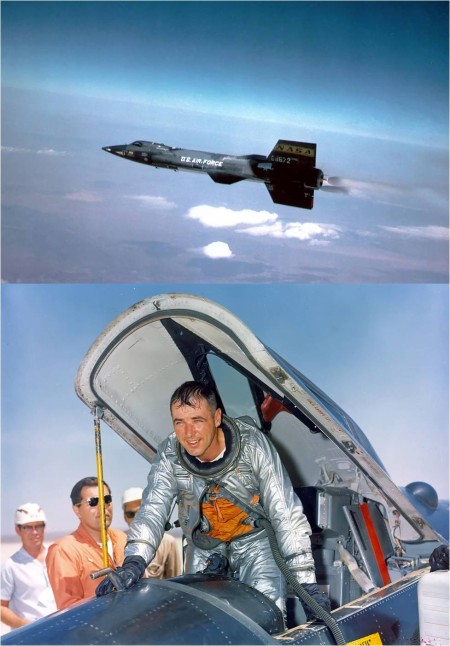
Fifty-one years ago this month, USAF Major Robert M. White flew the North American X-15 hypersonic research aircraft to a record altitude of 314,750 feet (51.8 nautical miles). In doing so, he became the first X-15 pilot to be awarded USAF Astronaut Wings.
The North American X-15 was the first manned hypersonic aircraft. It was designed, engineered, constructed and first flown in the 1950′s. As originally conceived, the X-15 was designed to reach 4,000 mph (Mach 6) and 250,000 feet. Before its flight test career was over, the type would meet and exceed both performance goals.
North American built a trio of X-15 airframes; Ship No. 1 (S/N 56-6670), Ship No. 2 (56-6671) and Ship No. 3 (56-6672). The X-15 measured 50 feet in length, had a wing span of 22 feet and a GTOW of 33,000 lbs. Ship No. 2 would later be modified to the X-15A-2 enhanced performance configuration. The X-15A-2 had a length of 52.5 feet and a GTOW of around 56,000 lbs.
The Reaction Motors XLR-99 rocket engine powered the X-15. The small, but mighty XLR-99 generated 57,000 pounds of sea level thrust at full-throttle. It weighed only 910 pounds. The XLR-99 used anhydrous ammonia and LOX as propellants. Burn time varied between 83 seconds for the stock X-15 and about 150 seconds for the X-15A-2.
The X-15 was carried to drop conditions (typically Mach 0.8 at 42,000 feet) by a B-52 mothership. A pair of aircraft were used for this purpose; a B-52A (S/N 52-003) and a B-52B (S/N 52-008). Once dropped from the mothership, the X-15 pilot lit the XLR-99 to accelerate the aircraft. The X-15A-2 also carried a pair of drop tanks which provided propellants for a longer burn time than was possible with the stock X-15 flight.
The X-15 employed both aerodynamic and reaction flight controls. The latter were required to maintain vehicle attitude in space-equivalent flight. The X-15 pilot wore a full-pressure suit in consequence of the aircraft’s extreme altitude capability. The typical X-15 drop-to-landing flight duration was on the order of 10 minutes. All X-15 landings were performed deadstick.
On Tuesday, 17 July 1962, Bob White flew his 15th X-15 mission. The X-15 and White had already become the first aircraft-pilot duo to hit Mach 4, 5 and 6. On this particular day, White was at the controls of X-15 Ship No. 3. It was the 62nd flight research mission of the X-15 Program with a target maximum altitude of 282,000 feet.
At 09:31:10 UTC, X-15 Ship No. 3 was launched from the B-52B mothership commanded by USAF Captain Jack Allavie. White lit the XLR-99 and pulled into a steep climb. His hypersonic steed rapidly gained altitude. Burnout of the XLR-99 occurred 82 seconds after ignition; 2.0 seconds longer than planned. At this point, White was traveling at 3,832 mph or Mach 5.45. Following an uneventful climb to apogee and a expertly-flown reentry, White touched-down safely on Rogers Dry Lake at 09:41:30 UTC.
The extra impulse provided by the longer-than-planned burn of the XLR-99 rocket engine drove White’s X-15 more than 32,000 feet higher than planned. The resulting apogee of 314,750 feet established a still-standing FAI world altitude record for piloted aircraft. The occasion also marked the first time that the X-15 flew higher than 300,000 feet. For flying beyond 50 statute miles (264,000 feet), Bob White received USAF Astronaut Wings; the first X-15 pilot to be awarded such.
Bob White piloted the X-15 a total of sixteen (16) times. He was one (1) of only twelve (12) men to fly the aircraft. White left X-15 Program and Edwards AFB in 1963. He went on to serve his country in numerous capacities as a member of the Air Force including flying 70 combat missions in Viet Nam. He returned to Edwards AFB as AFFTC Commander in August of 1970.
Major General Robert M. White retired from the United States Air Force in 1981. During his period of military service, he received numerous decorations and awards including the Air Force Cross, Distinguished Service Medal, Silver Star with three oak leaf clusters, Legion of Merit, Distinguished Flying Cross with four oak leaf clusters, Bronze Star Medal, and Air Medal with 16 oak leaf clusters.
Bob White was a true American hero. He was one of those heroes who neither sought nor received much notoreity for his accomplishments. He served his country and the aviation profession well. Bob White’s final flight occurred on Wednesday, 17 March 2010. He was 85 years of age.
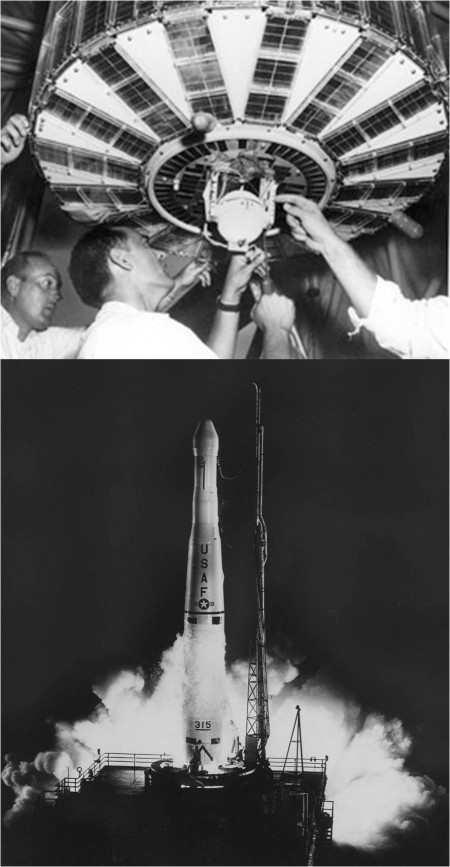
Fifty-two years ago this week, the United States Navy successfully orbited the Transit 4A navigation satellite which carried the SNAP-3A Radioisotope Thermoelectric Generator (RTG). This historic mission marked the first time that an RTG was used as a spacecraft power source.
Transit was the first operational satellite navigation system. More formally known as the Navy NAVSAT (Navigation Satellite) System, Transit provided accurate global position data in support of naval worldwide sea operations. The navigation of submarines and surface ships was greatly aided by Transit-provided data as were sundry hydrographic and geodetic surveying programs.
Transit was developed for the Navy by the Applied Physics Laboratory of the Johns Hopkins University (JHU/APL). Work began in 1958 and launch of the first prototype Transit satellite, Transit 1A, took place in September 1959. A number of Transit satellite launches took place over the next 5 years with the system going operational in 1964.
Transit satellites provided position data that was accurate to within about 3 feet. The system revolutionized global navigation and was ultimately used by an untold number of ships and boats. Transit navigational operations ceased in 1996 with the advent of the Global Positioning System (GPS). One of the great benefits of GPS is that position data are provided continuously whereas Transit provided discrete data about once an hour.
Transit 4A was unique in that an experimental Radioisotope Thermoelectric Generator (RTG) was carried onboard the spacecraft. An RTG coverts the heat generated by the natural decay of a radioisotope fuel into electricity. This device is especially useful for power generation applications where solar arrays are either impractical or inadequate. An example application would be a long duration mission in deep space.
The 3-watt RTG carried onboard Transit 4A was officially known as the Systems For Nuclear Auxiliary Power (SNAP-3). Being experimental in nature, it only provided power to instrumentation and a pair of Transit 4A’s quartet of radio transmitters. Later versions would provide power for all spacecraft systems.
The Transit 4A satellite was cylindrical in shape, measuring 43 inches in diameter and 31 inches in height. The spacecraft weighed 174 lbs. The majority of its external surface was covered with solar cells that charged nickel-cadmium batteries.
On Thursday, 29 June 1961, Transit 4A was launched from Cape Canaveral’s LC-17B at 04:22 UTC. The Thor Ablestar 315 launch vehicle successfully placed Transit 4A into a 596-nm x 515-nm earth orbit. Two other satellites (GRAB and Injun) were also orbited on this mission. They separated from Transit 4A, but not from each other. GRAB 3 had a SIGINT mission. Injun was a USN satellite investigating radiation in Earth’s magnetosphere.
Transit 4A became the longest continuous broadcasting spacecraft in 1966. It continued to hold that distinction through 1971; the type’s 10th anniversary in space. At that point, the satellite had traveled more than 1.7 billion miles in space and flown around the Earth more than 55,000 times.
By the end of 1996, the Transit satellites were no longer utilized for navigation purposes and were superseded by the Navstar Global Positioning System (GPS). However, Transit satellite systems were still operating well and the spacecraft continued to transmit valuable data from orbit. The Navy renamed the Transit Satellite System as the Navy Ionospheric Monitoring Systems (NIMS).
The RTG technology pioneered on the Transit 4A mission matured significantly over the next five decades. During that time, RTG’s provided a safe, reliable, and maintenance-free means for generating spacecraft thermal and electrical power. Indeed, RTG’s have proven pivotal to the success of numerous manned and unmanned space missions including those associated with the Apollo, Viking, Pioneer, Voyager, Galileo, Ulysses, and Cassini Programs.
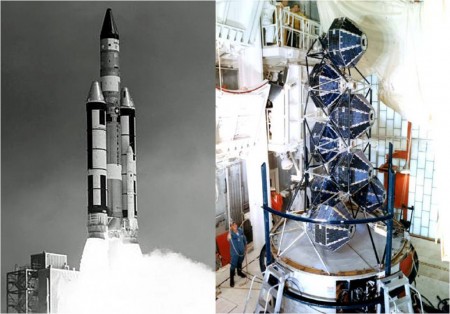
Forty-seven years ago this week, USAF’s Space and Missile Systems Organization (SAMSO) successfully orbited an octet of satellites on the first mission of the Initial Defense Communication Satellite Program (IDCSP). This feat marked the beginning of America’s first operational geosynchronous orbital communications system.
The Initial Defense Communications Satellite Program (IDCSP) was the world’s first military satellite communications system. It consisted of clusters of small, polygonal satellites deployed in near-geosynchronous earth orbit. IDCSP satellites transmitted both voice and photographic data vital to U.S. military commanders.
Each IDCSP satellite external configuration was a 26 sided polygon measuring 34-inches in diameter. With a mass of roughly 100 lbs, the communication satellite was spin-stabilized and its external surface was almost completely covered with solar cells. With the onus on simplicity, the type employed neither internal storage batteries nor an active attitude control system.
During a typical IDCSP mission, up to eight (8) satellites were placed into near-geosynchronous earth orbit by a single launch vehicle. Each satellite was dispensed individually. Since their orbits were not quite synchronous, IDCSP satellites drifted west to east up to 30 degrees per day. This feature helped ensure that at least one satellite was always visible to a ground station in the event that an adjacent IDCSP satellite became non-op.
On Thursday, 16 June 16 1966, an USAF Titan IIIC launch vehicle lifted-off from Cape Canaveral’s LC-41 at 1400 UTC. The multi-staged booster successfully placed seven (7) IDCSP satellites and a single gravity-gradient experimental satellite into equatorial orbit at an altitude of approximately 18,354 nm. Each of the constituent satellites functioned well and successfully passed a series of on-orbit preliminary tests. The IDCSP system then declared “operational” in short order.
Between June of 1966 and June of 1968, a total of twenty-six (26) IDCSP satellites were orbited by USAF Titan IIIC launch vehicles. A quartet of launches was required to accomplish such. While the IDCSP system was experimental in nature, it in fact provided the United States with a viable space-based, global communication network for over a decade.
IDCSP satellites transmitted reconn photographs and other intelligence data throughout the Vietnam War. At the point of IDCSP initial operating capability (IOC), the system was redesignated as the Defense Satellite Communications System I (DSCS I). Enhanced-capability variants, DSCS II and DSCS III, came in succeeding years (the later serving into the 21st century).

Forty-eight years ago this month, Astronaut Edward H. White II became the first American to perform what in NASA parlance is referred to as an Extra Vehicular Activity (EVA). In everyday terms; a space walk.
White, Mission Commander James A. McDivitt and their Gemini IV spacecraft were launched into low Earth orbit by a two-stage Titan II launch vehicle from LC-19 at Cape Canaveral Air Force Station, Florida. The mission clock started at 15:15:59 UTC on Thursday, 03 June 1965.
On the third orbit, less than five hours after launch, White opened the Gemini IV starboard hatch. He stood in his seat and mounted a camera to capture his historic space stroll. He then cast-off from Gemini IV and became a human satellite.
White was tethered to Gemini IV via a 15-foot umbilical that provided oxygen and communications to his EVA suit. A gold-plated visor on his helmet protected his eyes from the searing glare of the sun. The space-walking astronaut was also outfitted with a hand-held maneuvering unit that used compressed oxygen to power its small thrusters. And, like any good tourist, he also took along a camera.
Ed White had the time of his all-too-brief life in the 22 minutes that he walked in space. The sight of the earth, the spacecraft, the sun, the vastness of space, the freedom of movement all combined to make him exclaim at one point, “I feel like a million dollars!”.
Presently, it was time to get back into the spacecraft. But, couldn’t he just stay outside a little longer? NASA Mission Control and Commander McDivitt were firm. It was time to get back in; now! He grudgingly complied with the request/order, plaintively saying: “It’s the saddest moment of my life!”
As Ed White got back into his seat, he and McDivitt struggled to lock the starboard hatch. Both men were exhausted, but ebullient as they mused about the successful completion of America’s first space walk.
Gemini IV would eventually orbit the Earth 62 times before splashing-down in the Atlantic Ocean at 17:12:11 GMT on Sunday, 07 June 1965. The 4-day mission was another milestone in America’s quest for the moon.
The mission was over and yet Ed White was still a little tired. But then, that was really quite easy to understand. In the time that he was working outside the spacecraft, Gemini IV had traveled almost a third of the way around the Earth.
Now, that’s a long walk!
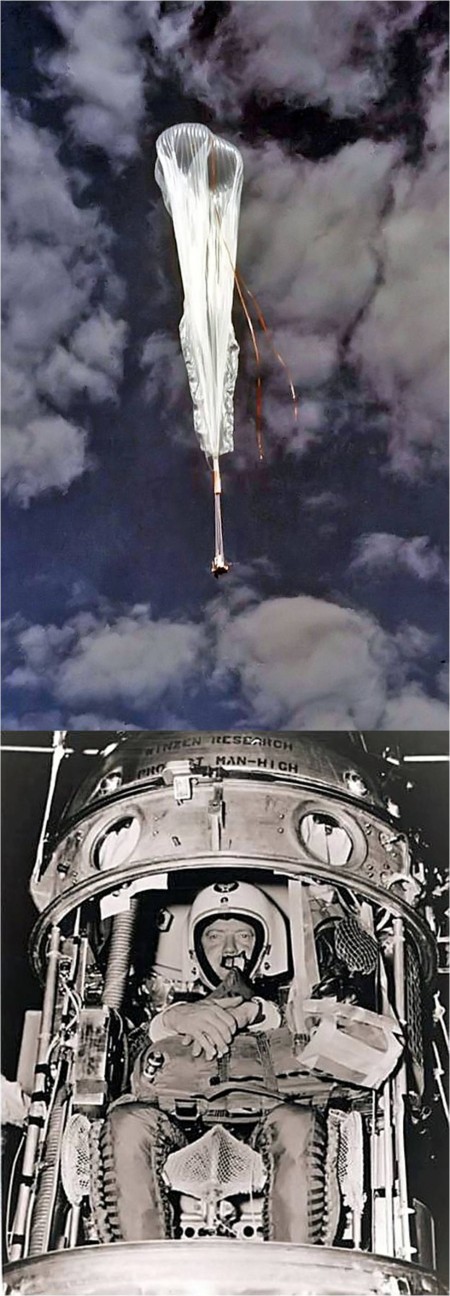
Fifty-six years ago this month, USAF Captain Joseph W. Kittinger successfully completed the first Manhigh aero medical research balloon mission. During his 6.5-hour flight, Kittinger reached an altitude of 95,200 feet above mean sea level.
Project Manhigh was a United States Air Force biomedical research program that investigated the human factors of spaceflight by taking men into a near-space environment. Preparations for the trio of Manhigh flights began in 1955. The experience and data gleaned from Manhigh were instrumental to the success of the nation’s early manned spaceflight effort.
The Manhigh target altitude was approximately 100,000 feet above sea level. A helium-filled polyethylene balloon, just 0.0015-inches thick and inflatable to a maximum volume of over 3-million cubic feet, carried the Manhigh gondola into the stratosphere. At float altitude, this balloon expanded to a diameter of about 200 feet.
The Manhigh gondola was a hemispherically-capped cylinder that measured 3-feet in diameter and 8-feet in length. It was attached to the transporting balloon via a 40-foot diameter recovery parachute. Although compact, the gondola was amply provisioned with the necessities of flight including life support, power and communication systems. It also included expendable ballast for use in controlling the altitude of the Manhigh balloon.
The Manhigh test pilot wore a T-1 partial pressure suit during the Manhigh mission. This would protect him in the event that the gondola cabin lost pressure at extreme altitude. The pilot was hooked-up to a variety of sensors which transmitted his biomedical information to the ground throughout the flight. This allowed medicos on the ground to keep a constant tab on the pilot’s physical status.
The flight of Manhigh I took place on Sunday, 02 June 1957 with USAF Captain Joseph W. Kittinger as pilot. The massive balloon carrying Kittinger and his gondola was released at 11:23 UTC from Fleming Field Airport, South Saint Paul, Minnesota. In less than 2 hours, Kittinger’s balloon reached its design float altitude of 95,200 feet.
Radio communication problems complicated the Manhigh I mission. While Kittinger could hear the ground, the ground could not hear him. However, the resourceful pilot managed to work around this issue by communicating with the ground via Morse code.
Though balloon, gondola and pilot were functioning quite well, the Manhigh I mission had to be cut short due to rapid depletion of the gondala’s oxygen supply. Post-flight investigation revealed that this anomaly was caused by accidental crossing of the oxygen supply and vent lines prior to the flight.
Kittinger made a safe and uneventful landing near Indian Creek, Minnesota; located roughly 60 nm southeast of the launch site. The recovery crew was quick to the scene and extracted the plucky pilot from the sealed balloon gondola which had fallen over on its side. The official mission elapsed time was 6 hours and 32 minutes.
The flight of Manhigh I was a significant technical accomplishment that materially contributed to the advancement of manned spaceflight. Indeed, a TIME Magazine article, entitled “Prelude to Space” and dated 17 June 1957, captured the essence of the achievement. A man had been subjected to space-equivalent physiological conditions for a protracted period, had functioned well in that environment, and then returned safely to earth without ill effect.
For his significant efforts during the Manhigh I mission, Captain Joseph W. Kittinger received the USAF Distinguished Flying Cross.











